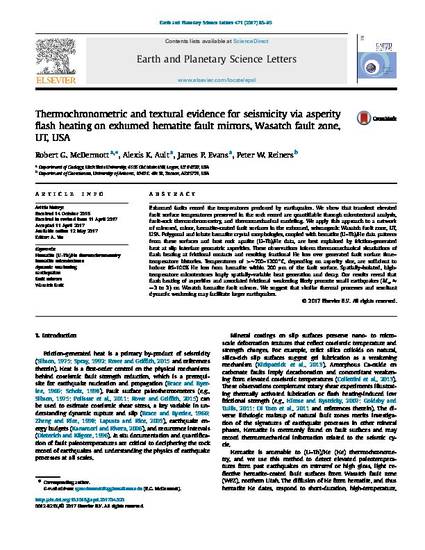
Article
Thermochronometric and textural evidence for seismicity via asperity flash heating on exhumed hematite fault mirrors, Wasatch fault zone, UT, USA
Earth and Planetary Science Letters
(2017)
Abstract
Exhumed faults record the temperatures produced by earthquakes. We show that transient elevated fault surface temperatures preserved in the rock record are quantifiable through microtextural analysis, fault-rock thermochronometry, and thermomechanical modeling. We apply this approach to a network of mirrored, minor, hematite-coated fault surfaces in the exhumed, seismogenic Wasatch fault zone, UT, USA. Polygonal and lobate hematite crystal morphologies, coupled with hematite (U–Th)/He data patterns from these surfaces and host rock apatite (U–Th)/He data, are best explained by friction-generated heat at slip interface geometric asperities. These observations inform thermomechanical simulations of flash heating at frictional contacts and resulting fractional He loss over generated fault surface time–temperature histories. Temperatures of >∼700–1200◦C, depending on asperity size, are sufficient to induce 85–100% He loss from hematite within 200 μm of the fault surface. Spatially-isolated, high-temperature microtextures imply spatially-variable heat generation and decay. Our results reveal that flash heating of asperities and associated frictional weakening likely promote small earthquakes (Mw≈−3to 3) on Wasatch hematite fault mirrors. We suggest that similar thermal processes and resultant dynamic weakening may facilitate larger earthquakes.
Disciplines
Publication Date
2017
DOI
https://doi.org/10.1016/j.epsl.2017.04.020
Citation Information
Robert McDermott, Alexis K Ault, James P. Evans and Peter W Reiners. "Thermochronometric and textural evidence for seismicity via asperity flash heating on exhumed hematite fault mirrors, Wasatch fault zone, UT, USA" Earth and Planetary Science Letters Vol. 471 (2017) p. 85 - 93 ISSN: 0012-821X Available at: http://works.bepress.com/james_evans/123/
Creative Commons license

This work is licensed under a Creative Commons CC_BY International License.
